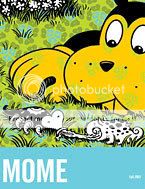Mome Vol. 9: Fall 2007
Ray Fenwick, Tim Hensley, Al Columbia, Eleanor Davis, Jim Woodring, Gabrielle Bell, Andrice Arp, Joe Kimball, Mike Scheer, Tom Kaczynski, Brian Evenson & Zak Sally, Kurt Wolfgang, Paul Hornschemeier, Sophie Crumb, writers/artists
Eric Reynolds & Gary Groth, editors
Fantagraphics, October 2007
120 pages
$14.95
Mome Vol. 9 by contributor, in order of appearance:
* Ray Fenwick’s text-heavy pin-up pages, drawn on the dismembered back covers of old hardcover books, mostly do that ironic combination of grandiose language and quotidian concerns, but for my money his best gags are the simplest. His “FUCK YOU AND YOUR BLOG” page, where that line of text is juxtaposed with a jauntily floating balloon, is a little easy but still made me think of scanning it and posting it on message boards; the conclusion of his first piece, which states that your estranged former best friend is “not available for comment,” hit me like a punch in the gut.
* Tim Hensley’s Wally Gropius strips have always been both funny and interesting to me in their absurdist, angular deconstruction of old Archie visual and narrative tropes, but I think this is the volume where they really made me sit up and take notice. The panel to panel physical business in the library-based strip “Shh!” is a delight to behold, and the incestuous conclusion to “Jillian in ‘The Argument'” is a note-perfect, savage lampoon of Sam-and-Diane-style “enemies become lovers” rom-com rhythms.
* Al Columbia can draw like a motherfucker but that’s really the only thing I got out of his Hansel & Gretel pastiche. Aside from the kiddie-killer’s creepy face it wasn’t really funny or scary.
* Eleanor Davis’s tale of two brothers and the abandoned house they discover in the woods reads like a cross between her usual monster-myth beat and the observational-drama family matters of her minicomic Mattie & Dodi. I’d probably still prefer the straight-up former to a combination of the two. However, Davis’s ambiguous treatment of what the brothers experience in the house and the casual fraternal violence of its aftermath is certainly unsettling.
* The first half of Jim Woodring’s “The Lute String” is a bonanza of adorably mischievous drawings of Pupshaw and Pushpaw, weird fungal creatures and transformations that gently trigger a phobia I have about growths, and a portrait of what God looks like in the world of Frank. (He’s an elephant!) Woodring comics are funny and scary and beautiful and look like Woodring comics and nothing else, which is a colossal achievement.
* I don’t get why Gabrielle Bell spots blacks the way she does. It clutters the image and distracts from the rhythm of the page.
* Andrice Arp does her own thing with another adaptation of a pre-Revolutionary War anti-English broadside. What’s interesting about these is how astutely they simulate what comics probably would have looked like had comics proper been around at that time, not just in terms of the character designs and typography but the metaphorical visual vocabulary itself–a haughty English captain vomiting his heavily taxed tea down the throats of helpless colonists, for example.
* Joe Kimball’s vertiginous page layouts and masterful graytones maintain the eerie air of his previous contribution to the series, but the comparatively straightforward visuals and storyline–involving an old man returning to his vampiric lover for one last embrace–reveal limitations in his figurework and storytelling.
* Mike Scheer’s art is indeed astonishingly lush given that it was created in ballpoint pen, but beyond that I don’t connect with it. I like the overly long titles he gives each piece, though.
* Tom Kaczynksi’s vaguely Ballardian tale of a young couple traumatized by the construction of a high-rise condo in their ersatz neighborhood is another of his capitalist cautionary tales, and like the earlier ones it somehow never feels didactic despite the potential for lecturing or hectoring. I think it might be because he is primarily concerned with the emotional impact of consumer society rather than the political, philosophical, or economic impact. The narration is just shy of hard-boiled, which is funny, and placing his story right after one of Bell’s makes for an interesting contrast in terms of how the two artists differ in their depictions of urban ennui–Kaczynski is colder and sharper, and while his characters lack the warmth of Bell’s his pages convey their information more dynamically and convincingly.
* Zak Sally’s adaptation of horror writer Brian Evenson’s shifting-identity body-horror story “Dread” is a case of designy typography overwhelming whatever power the story itself might have had.
* At this point Kurt Wolfgang’s Bagge-esque cartooning is almost as out of place in Mome visually as Sophie Crumb, and it’s not the kind of style I gravitate to naturally, but the fact that his story’s premise is “last night before the end of the world” is a hell of a way to keep you eagerly coming back in anticipation of the climax. With my luck nothing will happen.
* This is the most effective chapter of Paul Hornschemeier’s “Life with Mr. Dangerous” so far, and not just because of the nudity–I just really liked the panel where our heroine’s murmur of “I’m sorry” to her absent boyfriend is partially drowned out by her one-night-stand’s snores.
* Sophie Crumb…I don’t see the appeal.
Tags: comics, comics reviews, Comics Time, reviews

